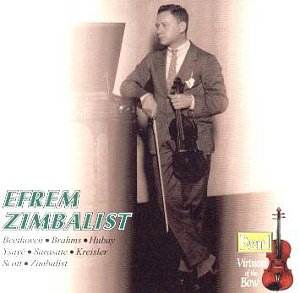Once lauded as one of the Holy Trinity of Auer students
(along with Heifetz and Elman) Carl Flesch was already sniping
at him in the 1920s and 1930s, asserting that Toscha Seidel more
properly deserved Zimbalist’s place. Indeed listening to Seidel’s
hot blooded and vivacious (if intellectually erratic) playing
is in almost grotesque distinction to Zimbalist’s patrician nobility,
exemplified by his sometimes woefully slow vibrato. Seidel imbued
morceaux with coruscatingly intense life; Zimbalist varnished
them with jewelled aloofness. The latter however could do with
some CDs to his name as befits his importance and this Pearl intelligently
collates his most important recordings – the Brahms and Ysaye,
the only long length commercial discs he recorded, with the exception
of the famous 1915 Bach Double Concerto with Kreisler. It also
includes some of the Japanese sides he made – he was exceptionally
popular there.
The disc starts with his pristine phrasing in
the Beethoven Romance, a performance somewhat vitiated by the
galumphing basses of the Japanese radio orchestra. But it’s the
next two items on which Zimbalist’s meagre heavyweight sonata
reputation rests. The Brahms (recorded in 1930) receives a pliant
and noble reading. Unaggressive in the opening Allegro, with Kaufman
blending well with Zimbalist, whose little subtle rhythmic nuances
are of the greatest interest. We can also immediately hear his
violinistic ethos, his musical-tonal aesthetic, which is analogous
to another Auer pupil, Kathleen Parlow. Neither radiates provocatively
irradiating tonal allure and Zimbalist tends to value lyric generosity
over romantic passion. His ardour, such as it is, is essentially
introspective and one that abjures theatrical flourish. His slow
vibrato is occasionally warmed by expressive power but, in the
main, reflection and a steady architectural surety are his aims.
Of course, as with almost all violinists, he lavishes greater
intensity and colour in the Adagio, calibrated well, affectionate
and aristocratic. His third movement is well characterised – if
the vibrato were faster he might be able to vest it with quicker
wit – though again lacking flourish. The finale has intellectual
clarity and control in profusion, some quick finger position changes
and even though both Zimbalist and Kaufman could be more athletic
it’s a successful performance on its own terms – those of clarity
and refinement and a cool, sometimes dispassionate, objectivity.
The Ysaye Solo Sonata No. 1 in G was dedicated
to Szigeti and its opening recalls Bach’s Sonata in the same key
(a favourite warm up piece of his). The Grave is, in Zimbalist’s
hands, affecting without becoming emotive. He doesn’t dig into
the G string and vibrance is limited but his technical equipment
is fine – some brilliant bowing and left hand pizzicato all negotiated
with nonchalance but not indifference. There’s some swish on the
78 used with does intrude somewhat. If the Fugato isn’t projected
with quite enough drama he phrases the Allegretto with dancing
blitheness and excellent rhythm (albeit slow vibrato in the lower
strings especially). His Hubay Zephyr opens like the clappers
– what kind of wind was blowing in the studio that day in August
1928? – but thankfully he slows down. His trill is excellent,
harmonics tremendous and he doesn’t make an expressive meal of
the contrastive material – he has other architectural fish to
fry. Those wanting a bit of swash and buckle will have to look
elsewhere.
He recorded quite a bit of Sarasate but frankly
Sarasate was not his composer. He is athletic, technically excellent
– bravura bowing and gorgeous trills (Zimbalist was a formidable
technician as we have repeatedly seen) but the slow vibrato limits
both tension and theatrical projection and without them Sarasate
loses impact. The playing is pellucid but lacks titillating colour,
personalisation and, in the end, flair. He promoted Cyril Scott,
as did Heifetz and Kreisler, and plays After Sundown from the
Tallahassee Suite of 1910 with a sweet lyricism entirely in keeping
with Zimbalist’s own aesthetic preoccupations. His own Japanese
confection demonstrates just how big a draw he was in that country
and his Kreisler is an attractive end to this recital.
Notes are by well-known collector Lawrence Holdridge
who also made the judicious selection and the cover artwork is
the famous and gorgeously sepia tinted photo of the violinist
listening, fiddle and bow in hand, to a recording on the cabinet
gramophone. The Ysaye isn’t so easy to come across these days
and the Brahms has only been intermittently in the catalogue so,
whatever Carl Flesch may have thought, I strongly recommend acquaintance
with Zimbalist’s nobility and eloquence of expression in this
fine and splendidly transferred disc.
Jonathan Woolf

